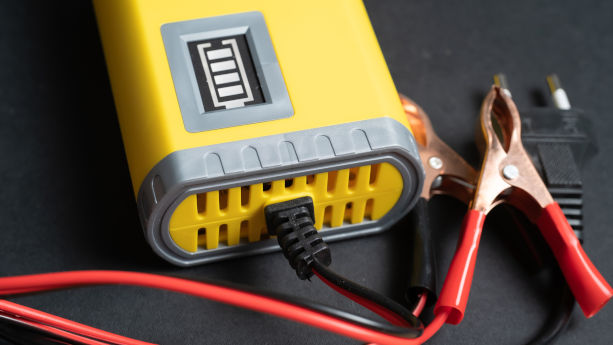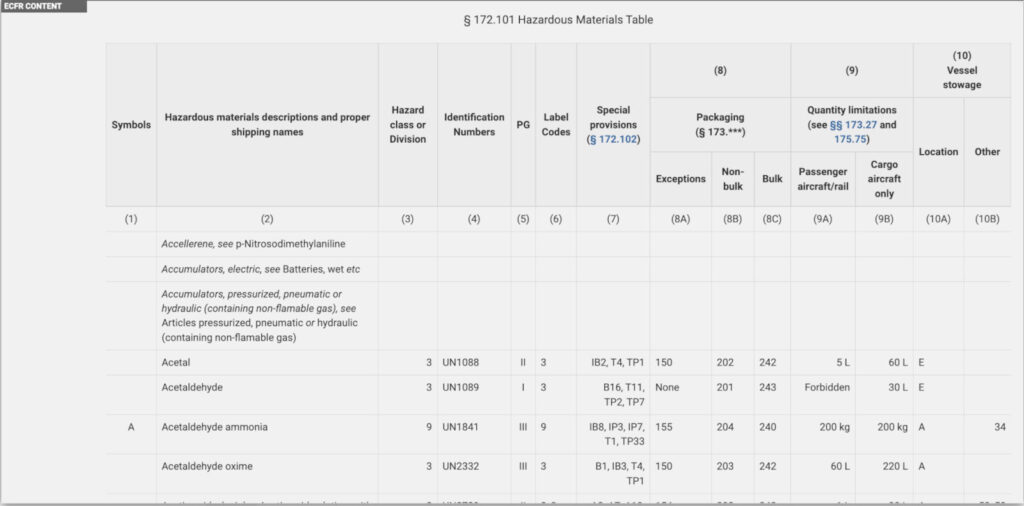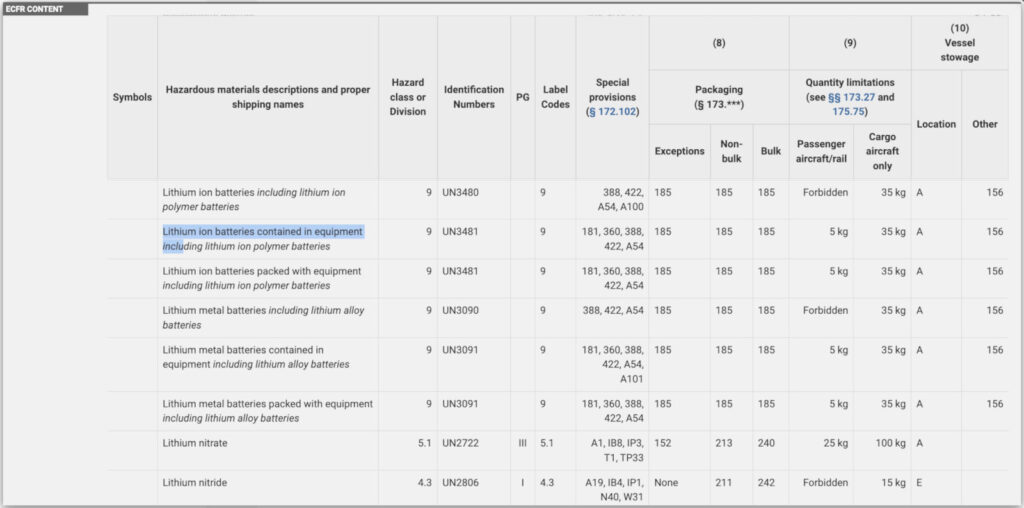
The Hazardous Materials Regulations sets requirements related to the transportation of dangerous materials, which include substances and products – such as batteries.
In this guide, we explain what the general requirements are and how US importers and manufacturers can use the Hazardous Materials Table to find relevant information concerning the requirements for their specific hazardous materials or product. We also provide a case study, focusing on the requirements for lithium batteries.
Content Overview

FREE CONSULTATION CALL (US, EU & UK)
- Request a free 30-minute call with Ivan Malloci to learn how we can help you with:
- Find product requirements
- Certification and labeling
- Lab testing
What are the Hazardous Materials Regulations?
The US Department of Transportation’s Pipeline and Hazardous Materials Safety Administration (PHMSA) developed the Hazardous Materials Regulations to ensure the secure transportation of materials that are deemed to be hazardous.
49 CFR Part 171.8 defines a “hazardous material” as a material that is unreasonably risky to one’s health, safety, and property during commercial transportation. Such substances include:
- Materials listed as hazardous in the Hazardous Materials Table
- Hazardous substances
- Hazardous wastes
- Marine pollutants
- Elevated temperature materials
These regulations govern the transportation of hazardous materials, such as lithium batteries, by aircraft, vessels, rail, and public highways. They require companies to comply with relevant requirements, including:
- Classification
- Testing
- Packaging
- Labeling
There are also additional requirements (e.g. special permits, approvals) that are only relevant for shipping companies.
Product examples
The Hazardous Materials Table provided in 49 CFR Part 172.101 lists various products that fall under the scope of the regulations, such as:
- Lithium-ion batteries
- Lithium metal batteries
- Vehicles
- Fireworks
- Printing inks
- Paints
The table also lists substances, such as:
- Lead nitrate
- Lithium
- Mercury
How do I find the requirements for my product?
The regulations apply to a broad range of products and substances, from batteries and vehicles to radioactive materials and explosives. For this reason, the requirements vary greatly, depending on factors such as hazard class and mode of transportation (e.g., passenger rail or cargo aircraft).
Hazardous Materials Table
The Hazardous Materials Table featured in 49 CFR Part 172.101 provides an overview and can be used as the starting point to find the requirements for the different types of hazardous materials. The same section also provides detailed explanations on how to read the table.
To access the whole table, click on the “Expand Table” button located in the table’s top left corner.
 Note: You can click on the image to enlarge it.
Note: You can click on the image to enlarge it.
Here we briefly explain the content of the table:
a. Column 1 – This column features six symbols (“+”, “A”, “D”, “G”, “I”, and “W), each one with a different meaning. For example, if the letter “A” is used, it means that such a material is subject to the requirements listed in this subchapter only when it is transported by aircraft.
b. Column 2 – This column lists a description of the hazardous material as well as the proper shipping name of said material. For example, “Lithium-ion batteries contained in equipment including lithium-ion polymer batteries”.
c. Column 3 – This column lists hazard classes or divisions for material, or the word “Forbidden”, which means that the material cannot be transported. Note that the hazard class for most batteries is “9”, which represents “miscellaneous hazardous material” that do not present any of the hazards listed in other classes.
d. Column 4 – This column lists the identification number (e.g. “UN3481”, or “UN 3090” for different types of lithium batteries).
e. Column 5 – This column lists packing groups, indicating the degree of danger of the materials, their proper shipping names, and hazard classes. For example, diallylamine belongs to packing group “II”, while this entry is usually not specified for batteries.
f. Column 6 – This column lists label codes representing the required hazard warning labels for the respective material. For example, the code for most batteries is “9”, which corresponds to the hazard class.
g. Column 7 – This column lists codes for special provisions provided in 49 CFR Part 172.102 for relevant hazardous materials. For example, these are some codes relevant to lithium batteries: “181, 360, 388, 422, A54”.
h. Column 8 – This column specifies relevant sections of the regulations concerning packaging provisions. As an example, 173.185 lists packaging requirements for lithium batteries.
i. Column 9 – This column specifies the quantity limitations for various materials when transported by aircraft or by rail (e.g., “forbidden, or “35 kg”).
j. Column 10 – This column specifies authorized stowage locations and handling requirements (e.g., category “A” stands for stowage “on deck” or “under deck” on passenger or cargo vessels).
Freight Forwarders
Freight forwarders help companies organize and coordinate freight from the manufacturing country to the country of importation, by contracting a carrier on the importer’s behalf.
Some freight forwarders can also help you determine compliance requirements relevant for the shipping of hazardous materials, or at least provide you with relevant information on:
- Material classification
- Packaging requirements
- Labeling requirements
- Relevant standards
- Necessary documentation (e.g., UN 38.3 test summary)
Regardless, you are still responsible for ensuring your product’s compliance with relevant requirements (e.g. testing your product and obtaining a valid test report).
Case Study: Lithium Batteries
In this section, we explain how you can navigate the Hazardous Materials Table by using lithium batteries as a case study.
Product Classification
The Hazardous Materials Table classifies lithium batteries according to their name and identification numbers. For example:
- Lithium ion batteries – UN3480
- Lithium ion polymer batteries – UN3481
- Lithium alloy batteries – UN3091
 Note: You can click on the image to enlarge it.
Note: You can click on the image to enlarge it.
Packaging Specifications
According to column 8 of the table, you can find packaging requirements for lithium batteries in 49 CFR Part 173.185. Here are a few examples of those requirements:
a. Lithium batteries should be packaged in such a way that short circuits, damages, and accidental activation are prevented.
b. Non-metallic inner packaging should enclose the entirety of the lithium battery.
c. Lithium batteries and other articles for transportation by aircraft, such as flammable gases, liquids, and solids, should not share the same outer packaging.
Packaging Labeling
49 CFR Part 173.185 also establishes labeling requirements.
Lithium battery mark
Packages containing lithium batteries must carry the lithium battery mark featured in this section, which should also indicate the UN number (e.g., “UN3090” for lithium metal cells or batteries).
Overpacks containing lithium batteries and their packages must clearly bear the lithium battery mark as well as the word “OVERPACK”.
Air shipments containing packages that must carry the lithium battery mark are required to include on the air waybill an indication that the packages within comply with:
- The requirements set in 49 CFR 173.185(c)(4), or
- The relevant ICAO Technical Instructions Packing Instruction
Other requirements
Unless the batteries are packed in quantities lower than 5 kg of net weight, the outer package should include a mark such as the following:
“PRIMARY LITHIUM BATTERIES—FORBIDDEN FOR TRANSPORT ABOARD PASSENGER AIRCRAFT”
You can find more examples in 49 CFR 173.185.
Special Provisions
Column 7 of the Hazardous Materials Table contains codes corresponding to specific special provisions. You can find those provisions listed in 49 CFR Part 172.102. There are different special provisions for different battery types. Here is one example:
Lithium ion batteries including lithium ion polymer batteries
This product has four special provision codes
- 388
- 422
- A54
- A100
For example, code 388 states that lithium batteries that comprise rechargeable lithium ion cells and primary lithium metal cells, both of which are not designed for external charging, must adhere to the following requirements:
a. The primary lithium metal cells must only charge the rechargeable lithium ion cells.
b. The rechargeable lithium ion cell’s design must render overcharging impossible.
c. The battery has undergone testing as a primary lithium battery.
d. The battery’s component cells must be UN 38.3 approved.
Test Summary
Lithium cells and batteries are subject to the tests described in Part III, subsection 38.3 of the UN Manual of Tests and Criteria. 49 CFR 173.185(a)(3) requires manufacturers and distributors to provide a test summary and includes details on the information that should be provided in the summary.
Amazon Requirements
Amazon requires sellers to comply with set requirements in its Fulfilled By Amazon (FBA) Dangerous Goods program when selling some types of batteries, such as the following:
- Lithium-ion batteries
- Lithium metal batteries
- Lithium-ion polymer batteries
This includes compliance with the Hazardous Materials Regulations. Specifically, sellers to upload the Test Summary when they’re setting up their ASIN.
Lab testing
Importers and manufacturers of hazardous materials need to have their products tested to prove compliance with regulatory requirements and standards.
When their products pass testing, they receive a test report that proves their products and materials comply with the regulations.
Test methods
Testing requirements depend on the material and relevant standards. Below, we provide some examples.
According to 49 CFR Part 173.185(c)(2), each package containing lithium cells or batteries is required to undergo a test in which it should:
- Withstand a drop of 1.2 meters, and
- Not release the package’s contents as a result of said drop
Additionally, lithium batteries must meet UN 38.3 requirements, as listed in the UN Manual of Tests and Criteria.
As another example, ASTM E681–85, Standard Test Method for Concentration Limits of Flammability of Chemicals, can be used to determine certain properties of flammable gases.
Test companies
Here we list a few companies that offer to test batteries to requirements in UN 38.3 or the Hazardous Materials Regulation:
- Bureau Veritas
- Intertek
- SGS
- Underwriters Laboratories (UL)
















 Create compliance checklists for your product (US, EU & UK)
Create compliance checklists for your product (US, EU & UK) 20+ product certificate templates
20+ product certificate templates Create label files
Create label files Book product testing
Book product testing